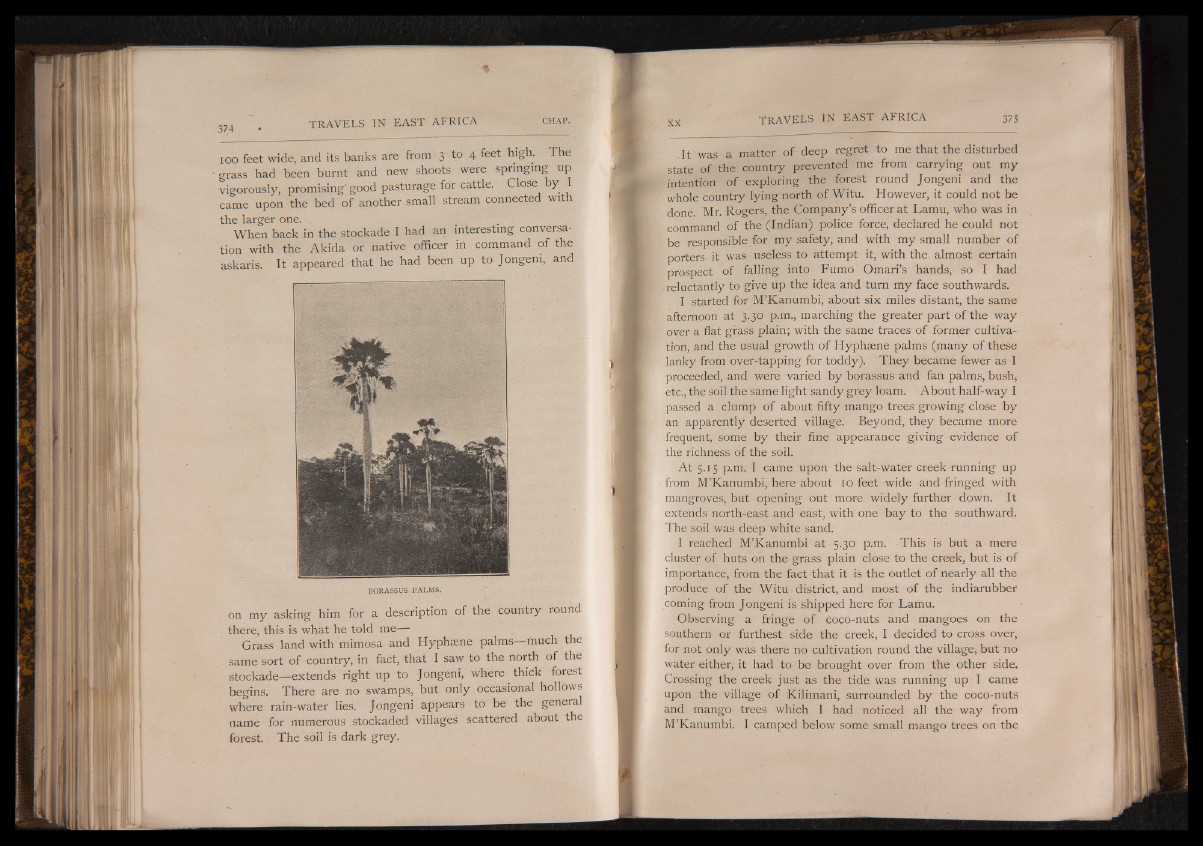
ioo feet wide, and its banks are from 3 to 4 hjlfh- The
grass had been burnt and new shoots were springing up
vigorously, promising' good pasturage for cattle. Close y
came upon the bed of another small stream connected with
the larger one.
When back in the stockade I had an interesting conversation
with the Akida or native officer in command of the
askaris. It appeared that he had been up to Jongeni, and
BORASSUS PALMS,
on my asking him for a description of the. country round
there, this is what he told me—-
Grass land with mimosa and Hyphsene palms much the
same sort of country, in fact, that I saw to the north of the
stockade— extends right up to Jongeni, where thick forest
begins. There are no swamps, but only occasional hollows
where rain-water lies. Jongeni appears to be the general
name for numerous stockaded villages scattered about the
forest. The soil is dark grey.
.It was a matter of deep regret to me that the disturbed
state of the country prevented me from carrying out my
intention of exploring the forest round Jongeni and the
whole country lying north of Witu. However, it could not be
done. Mr. Rogers, the Company’s officer at Lamu, who was in
command of the (Indian) police force, declared he could not
be responsible for my safety, and with my small number of
porters it was useless to attempt it, with the almost certain
prospect of falling into Fumo Omari’s hands, so I had
: reluctantly to give up the idea and turn my face southwards.
I started for M’Kanumbi, about six miles distant, the same
afternoon at 3.30 p.m., marching the greater part of the way
over a flat grass plain; with the same traces of former cultivation,
and the usual growth of Hyphsene palms (many of these
lanky from over-tapping for toddy). They became fewer as I
proceeded, and were varied by borassus and fan palms, bush,
etc., the soil the same light sandy grey loam. About half-way I
passed a clump of about fifty mango trees growing close by
an apparently deserted village. Beyond, they became more
frequent, some by their fine appearance giving evidence of
the richness of the soil.
At 5.15 p.m. I came upon the salt-water creek running up
from M’Kanumbi, here about 10 feet wide and fringed with
mangroves, but opening out more widely further down. It
extends north-east and east, with one bay to the southward.
The soil was deep white sand.
I reached M’Kanumbi at 5.30 p.m. This is but a mere
cluster of huts on the grass plain close to the creek, but is of
importance, from the fact that it is the outlet of nearly all the
produce of the Witu district, and most of the indiarubber
coming from Jongeni is shipped here for Lamu.
Observing a fringe of coco-nuts and mangoes on the
southern or furthest side the creek, I decided to cross over,
for not only was there no cultivation round the village, but no
water either, it had to be brought over from the other side.
Crossing the creek just as the tide was running up I came
upon the village of Kilimani, surrounded by the coco-nuts
and mango trees which I had noticed all the way from
M’Kanumbi. I camped below some small mango trees on the